#568 Red Sun Streaming January 07, 1997
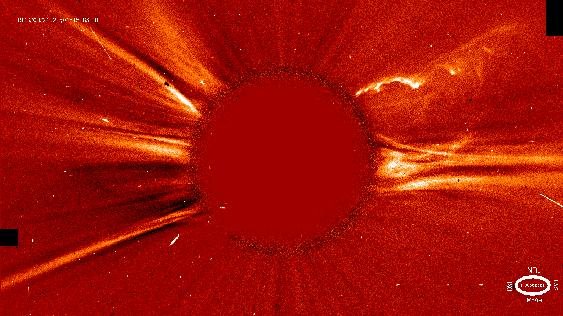
“The Sun is leaking. In fact, it is gushing: particles stream away from the Sun at hundreds of kilometers per second. Some of these particles strike the Earth and cause aurora. Most particles, however, either surround the Sun as a huge solar corona or glide into interstellar space as the solar wind. Don't worry about the Sun totally evaporating - it loses too little mass to have any lasting effect. The above false-color picture was taken with the Large Angle and Spectrometric Coronograph on board the SOlar and Heliospheric Observatory (SOHO). This instruments blocks out the central solar disk so it can image the regions surrounding the Sun. The large streamers visible are typical. Where these charged ions get their enormous streaming energy is still a mystery!"
Copyright: Public domain
#569 Grey Sun Seething January 08, 1997
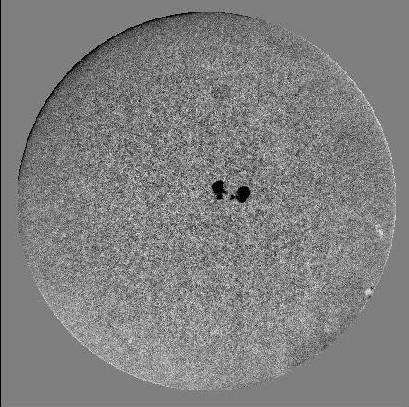
“The Sun's surface is not smooth. It has thousands of bumps called granules and usually a few dark depressions called sunspots. Each of the numerous granules is the size of an Earth continent, but much shorter lived. A granule can only be expected to last a few minutes before dissipating and being replaced by a newly rising granule. In this way a granule acts much like a rising bubble in boiling water. The above black and white, visible-light picture is quite unusual because the usual relative darkening visible near the edges of the Solar disk have been digitally removed. Visible near the center are two large sunspots while the computer enhancement brings out two bright plages close to the right solar limb. "
Copyright: Public domain
#570 Hazing Jupiter January 09, 1997
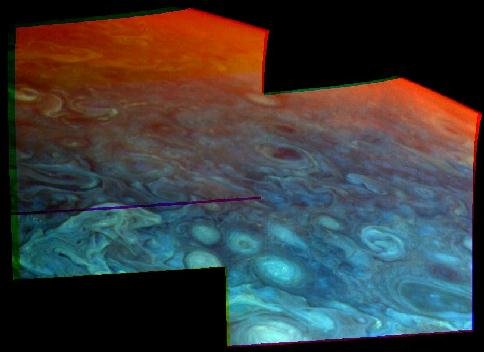
“A dramatic mosaic of recent images from the Galileo spacecraft reveals details of swirling clouds and a thick stratospheric haze in the atmosphere of Jupiter, the Solar System's largest planet. This false color representation is keyed to altitude - red indicates cloud features near the top of the gas giant's extensive atmosphere while blue corresponds to features at depth. North is up in the mosaic, centered at about 50 degrees northern Jovian latitude, and the limb or edge of the planet arcs across the upper right. The line of sight looking toward the limb emphasizes the high altitude, red haze. What causes the red haze? It may well be created as energetic electrons and other charged particles swept up by Jupiter's magnetosphere are funneled along magnetic field lines and bombard the atmosphere near the polar regions. Charged magnetospheric particles can also create Aurora."
Copyright: Public domain
#571 Eclipsed Moon in Infrared January 10, 1997
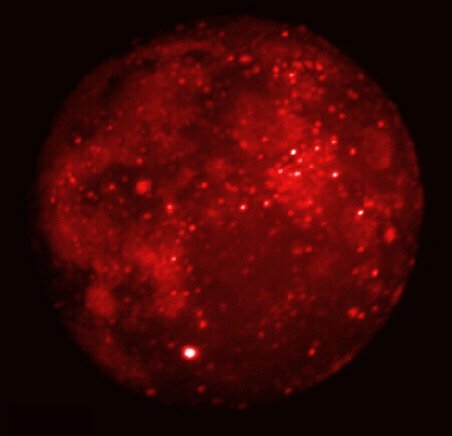
“Last September's total lunar eclipse disappointed many observers in the Eastern and Midwestern US who were cursed with cloudy skies. However, the Midcourse Space Experiment (MSX) satellite had a spectacular view from Earth orbit and SPIRIT III, an onboard imaging infrared telescope, was used to repeatedly image the moon during the eclipse. Above is one of the images taken during the 70 minute totality, the Moon completely immersed in the Earth's shadow. Infrared light has wavelengths longer than visible light - human's can not see it but feel it as heat. The bright spots correspond to the warm areas on the lunar surface, dark areas are cooler. The brightest spot below and left of center is the crater Tycho, the dark region at the upper right is the Mare Crisium. The series of SPIRIT III images allow the determination of cooling curves for geologically different areas, exploring the physical properties of the Moon's surface."
Copyright: Public domain
#572 Titania's Trenches January 11, 1997
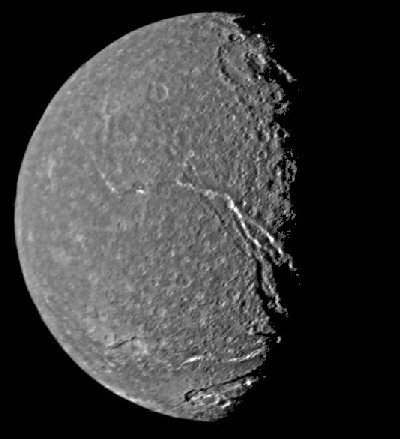
“British astronomer Sir William Herschel discovered Titania and Oberon in 1787, 210 years ago today. He wasn't reading Shakespeare's A Midsummer Night's Dream though, he was making the first telescopic observations of moons of the planet Uranus (a planet which he himself discovered in 1781). On January 24, 1986 NASA's robot explorer Voyager 2 became the only spacecraft to visit the remote Uranian system. Above is Voyager's highest resolution picture of Titania, Uranus' largest moon - a composite of two images recorded from a distance of 229,000 miles. The icy, rocky world is seen to be covered with impact craters. A prominent system of fault valleys, some nearly 1,000 miles long, are visible as trench-like features near the terminator (shadow line). Deposits of highly reflective material which may represent frost can be seen along the sun-facing valley walls. The large impact crater near the top, known as Gertrude, is about 180 miles across. At the bottom the 60 mile wide fault valley, Belmont Chasma, cuts into crater Ursula. Titania itself is 1,000 miles in diameter."
Copyright: Public domain
#573 Mercury in Stereo: Craters Within Craters January 12, 1997
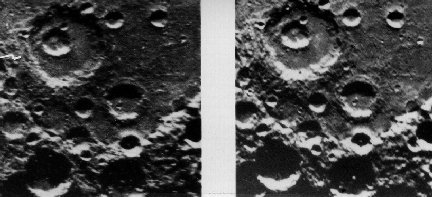
“This Stereo image pair of craters on on Mercury was produced using data from NASA's robot explorer Mariner 10 which performed three close flybys of the Sun's closest companion, two in 1974 and one in 1975. However, the spacecraft was not equipped with a Stereo camera! Instead, the Stereo pair was created using two images of the same region each recorded from a slightly different angle. The image on the left was actually taken during the first flyby, the one on the right during the second. A crater within a crater is visible at the upper left, the outer one is about 70 miles in diameter. The embedded craters themselves are within the 230 mile wide Dostoevsky crater - a segment of Dostoevsky's rim runs through the lower half of the image. To get the 3D Stereo effect, your left eye should see only the left image and your right eye only the right one. (Try placing one edge of a piece of paper on the screen between the pictures and touching your nose to the other edge while viewing.)"
Copyright: Public domain
#574 Sunspots: Magnetic Depressions January 13, 1997
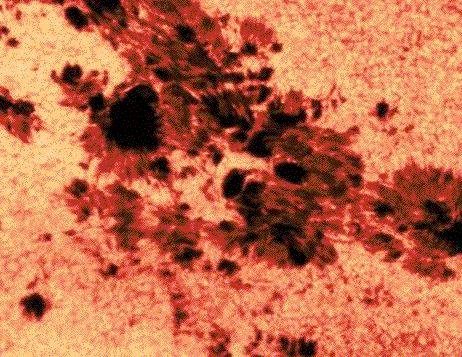
“Our Sun has spots! These spots appear dark in photographs like the one above, but in fact sunspots are quite bright - they are just dark compared to the rest of the Sun. Sunspots are about the size of the Earth and frequently occur in groups, as shown above. Sunspots occur when a concentrated portion of the Solar magnetic field pokes through the surface. This field slows energy from entering the sunspot region, causing sunspots to appear cooler, darker, and lower than the surrounding surface. Sunspots typically last about a month or two before dissipating. The number of sunspots is always changing, generally going from a maximum to a minimum about every 5 ½ years. In fact, the Sun just passed a minimum last year. The Sun and sunspots should never be looked at directly. "
Copyright: Public domain
#575 Black Holes in Galactic Centers January 14, 1997
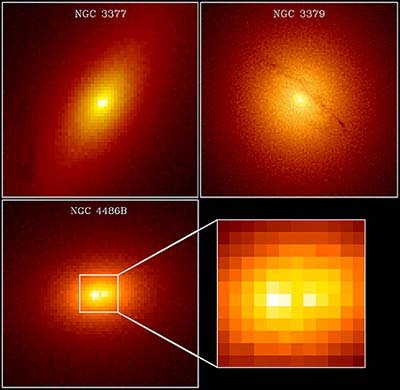
“Do all galaxies have black holes at their centers? Although not even a single galaxy has yet been proven to have a central black hole, the list of candidates has increased yet again. Recent results by astronomers using the Hubble Space Telescope now indicate that most - and possibly even all - large galaxies may harbor one of these dense beasts. In all the galaxies studied, star speeds continue to increase closer the very center. This in itself indicates a center millions of times more massive than our Sun is needed to contain the stars. This mass when combined with the limiting size make the case for the central black holes. Will we ever know for sure?"
Copyright: Public domain
Upvote! Resteem! Comment! As you like it! Thank you for attention!